“The Jiu-Jitsu I created was designed to give the weak ones a chance to face the heavy and strong.”
—Helio Gracie
Brazilian Jiu-Jitsu (BJJ) is experiencing a boom around the world, and you can now find gyms in most towns and cities.
More so than any other martial art, it’s made its way into popular media from The Matrix to the UFC to celebrity’s social media accounts.
What’s responsible for this upsurge in interest?
There are a few explanations:
- BJJ is a major component of mixed martial arts (MMA), which has become one of the most popular spectator sports in the world over the past two decades. Royce Gracie, an ardent practitioner of BJJ, also won three out of the first five Ultimate Fighting Championships (UFC), giving BJJ major bona fides.
- BJJ is considered by many to be one of (if not the) most well-rounded and practical methods of self defense.
- Research shows it’s safer than many other martial arts, especially those that involve fisticuffs, which makes it suitable for all ages and ability levels.
- It’s imbued with a positive, open, and unpretending atmosphere that makes it approachable for newbs.
- It offers perpetual opportunities for improvement. You’ll learn something new every class, and even the top dogs of the sport are ceaselessly burnishing their game.
Since you’re reading this, chances are good that the BJJ bug has nipped you too, and in this article, you’re going to learn everything you need to know to dip your toes in the water.
Whether you’ve only just heard of the sport, you’ve taken a few classes, or you’ve been training for years, you’ll get something out of this article.
Table of Contents
+
What Is Brazilian Jiu-Jitsu (BJJ)?
Brazilian Jiu-Jitsu is a martial art and combat sport centered on ground fighting.
The gist is to get your opponent on the ground, control their movements, and force them to submit (“tap out”) while thwarting their attempts to do the same to you. In Brazilian Jiu-Jitsu competitions, you can also defeat your opponent by winning more points (which are awarded by judges for accomplishing various maneuvers) even if neither of you submits.
The most apt description I’ve heard of the sport is that it’s “physical chess.” As in chess, the rules and possible paths to victory are known by both parties, and success pivots on identifying, adapting, and executing these strategies faster than your opponent.
The rub, of course, is that there are myriad options for how to submit your opponent and deflect their attacks, and learning when, how, and why to use all of these tools takes years of practice.
The more skilled the fighter, the more attacks and escapes they’ll have in their arsenal, and the more tools they can use to slip past your guard or wear you down. What’s more, they’ll have better judgement of what attacks and escapes to use and when, choosing the one that puts them in the best possible position while expending the least energy.
Many people participate in BJJ in order to get in shape, learn self defense, or to compete. In the latter case, competitions are managed and regulated by different organizations, but the most mainline is the International Brazilian Jiu-Jitsu Federation (IBJJF).
As mentioned a moment ago, BJJ is also a mainstay of Mixed Martial Arts (MMA) and is the cornerstone of hand-to-hand combat training in the US Army and many other militaries around the world.
The History of Brazilian Jiu-Jitsu
In 1914, a Japanese judoka, prizefighter, and teacher named Mitsuyo Maeda (mit-SOO-yo MY-da) stepped off the boat in Brazil. His mission was simple: to beat the drum for Judo as the supreme combat sport.
He barnstormed the country giving demonstrations and lessons, and galvanized a 14-year old boy named Gastão Gracie. Gracie became an avid pupil and promoter of Maeda’s teachings, and spread the word to his siblings, including his younger brother, Helio.
Carlos, Helio, and several other Gracie brothers took to the sport, and allied the grammar of Judo with their own experiences, preferences, and principles to create a new fighting style known as Brazilian Jiu-Jitsu, or BJJ.
The main rift between BJJ and Judo is that Judo focuses on throwing the opponent to the ground with little emphasis on what to do with them once they’re there, whereas BJJ focuses on how to submit an opponent on the ground with just enough instruction on throwing techniques to get them there.
To truly appreciate the genesis of Brazilian Jiu-Jitsu, though, you have to look further back in history to the Nara period of eighth century Japan, where Jujutsu (Japanese for “gentle art”) was birthed as a form of hand-to-hand combat to complement sword and spear fighting.
This nascent form of Jiu-Jitsu emphasized throwing, joint locks, and immobilization—techniques that were geared toward fighting armored and armed opponents. During the Edo period in the 17th and 18th centuries, industrialization superannuated Samurai warfare, and practitioners of Jujutsu began to prize techniques that were more suited to fighting unarmed opponents.
This fighting style evolved into Judo in the late 1800s shortly after the Meiji Restoration, found an audience in Brazil thanks to the boosterism of Maeda, and was then fashioned into Brazilian Jiu-Jitsu by the brothers Gracie and their progeny.
And that’s how an ancient martial art taught to the warrior-elite of feudal Japan made its way to the modern battlefield, primetime television, and the gym down the street. 🙂
Brazilian Jiu-Jitsu Belt Ranks
As with other martial arts, Brazilian Jiu-Jitsu incorporates a belt system to rank practitioners based on their skill level.
The six belts of BJJ are:
White Belt. The white belt is for people who are brand new to BJJ. As a white belt, your main goal is to learn the fundamentals of the sport such as survival postures, escapes, and basic submissions.
Blue Belt. The blue belt is the first belt in BJJ that’s earned based on your ability. As a blue belt, you should have a good knowledge of the main positions and escapes, understand the mechanics of basic submissions and takedowns, and be able to employ more technique while rolling, instead of relying on athleticism and instinct.
Purple Belt. The purple belt is the intermediate adult ranking in BJJ. By the time you reach purple belt, you’ll know from experience which positions and techniques suit your fighting style best. You’re also advanced enough to begin mentoring blue and white belts in class.
Brown Belt. The brown belt is the highest ranking belt before black. Being a brown belt is mostly about polishing the rough edges of your game to reach black belt. You are considered advanced at this stage.
Black Belt. The black belt denotes an expert level of technical and practical skill in BJJ. Brazilian Jiu-Jitsu black belts are master grapplers who have spent thousands of hours on the mat learning and refining technique. Black belts are generally teachers, often with their own school. There are also several advanced kinds of black belts known as “coral belts,” which are awarded to particularly adept fighters as they approach the red belt.
Red Belt. The red belt is the top flight of BJJ belts, and it’s reserved for fighters whose influence, fame, and input has advanced the sport as a whole. The red belt is largely ceremonial in nature, and is awarded based on your contribution to the sport, rather than your technical proficiency (although that’s also a factor).
The primary canon for advancing to the next belt level is your ability to perform various escapes and submissions at the right time.
Typically, your instructor or instructors will make a subjective assessment of your skill level based on your performance in class or competition, but some BJJ organizations also have more objective criteria (primarily for lower belt levels).
You may also see some people with white stripes on their belt, which are informal awards denoting progress within a belt level. For instance, it’s possible to be a three-stripe white belt, which would put you above a two-stripe white belt. Each BJJ gym has its own system for why and when stripes are awarded, although when used, you generally get four stripes before moving up to the next belt level.
One notable difference between BJJ and some other martial arts, like Karate, Taekwondo, or Aikido, is that it takes much longer to progress from one belt level to the next. For instance, it’s not uncommon for it to take two to three years of consistent practice to advance from a white belt to a blue belt, whereas this might only take six months in Karate. The BJJ black belt is also considered the hardest belt to reach in martial arts.
Brazilian Jiu-Jitsu Training Basics
Before stepping foot on a BJJ mat, it helps to know the nuts and bolts of the sport. Here are the biggies.
Hygiene
BJJ hygiene boils down to common sense: don’t smell bad, don’t scratch people, don’t smear effluence or germs on the mat and your opponents, shower, etc.
Here’s a more complete list:
- Don’t wear shoes on the mat.
- Wear flip flops when going to the bathroom or walking between the locker room and the mat.
- Trim your finger and toenails.
- Wear a clean gi or no-gi clothing.
- Shower regularly, use deodorant, and brush your teeth before class.
- Don’t train when you’re sick or think you might be.
- Cover any cuts or blisters with bandages.
All of that said, remember that you are going to be rassling with sweaty people—you’ll get a few errant fingers in the mouth, friction burns, and unwanted sweat showers. No bees, no honey, as they say.
Gear
You don’t need much in the way of gear or garb to participate in BJJ, but there are a few essential items:
Gi. A gi, also known as a kimono, is a loose-fitting, two-piece cotton garment consisting of a pair of pants and a jacket that’s held closed with a cloth belt. It’s a requirement if you participate in gi BJJ classes. These generally come in white, black, or blue, and you’ll want to check with your gym for what color they prefer (most leave it up to you).
Belt. You’ll need to buy a white belt for your first BJJ class, and many entry-level gis include one.
No-gi clothing. If you take a no-gi BJJ class, you’ll need to wear tight-fitting clothing without pockets, strings, or other doodads that can catch on things instead of a gi. A long-sleeve rashguard, leggings, and shorts without pockets (such as running or MMA shorts) work well.
Rashguard. Most people wear a long- or short-sleeve rashguard or some kind of protective clothing under their gi in order to protect against friction burns. Any kind of tight-fitting material works, but most prefer sweat-wicking clothes like Under Armor Heatgear or BJJ-specific undergarments.
Mouthguard. You don’t need a mouthguard for BJJ, but it’s a good idea to protect your teeth and tongue.
Flip flops. You’ll need a pair to wear between the locker room and the mat.
Athletic tape. You don’t need this, but it’s helpful for protecting your knuckles from friction burns and sprains.
Etiquette
The decorum of BJJ is straightforward:
- Give a short bow before you step onto the mat. This isn’t required, but it’s considered polite.
- Don’t talk over the instructor (duh).
- Don’t go too hard when learning a new technique. You don’t win plaudits for piss and vinegar, but for patience and progress.
- Focus on learning, teaching, and collaborating instead of winning, preening, and dominating. Don’t be afraid to ask your opponent questions or to demonstrate particular moves—even while sparring—and be gracious in doing the same for others.
- Safety first. If you and your opponent are about to roll into another pair of students or the wall, stop for a moment, move so you have more space, then restart from the same position.
- Make sure your opponent is ready before you start rolling (sparring). (See the “slap-bump” below).
Submissions
A submission is any technique that controls, hurts, or subdues your opponent, causing them to “submit” when applied successfully.
There are numberless submissions to choose from, and each works in slightly different ways and targets different parts of the body. For example, the armbar hyperextends the elbow, the kimura hyper-rotates the shoulder, the ankle lock hyperextends the ankle and crushes the Achilles tendon, and the rear naked choke restricts blood flow to the brain.
Which submission you select depends on your opponent, personal anatomy and preferences, skill level, position, and many other factors. Learning a range of different submissions and when and how to apply them is part of the warp and woof of BJJ.
Escapes
An escape is any technique that allows you to dodge a submission or get out of a disadvantageous position (such as a mount).
While you can’t beat someone using escapes alone, you can avoid getting beaten if you use them properly.
Sweeps
A sweep is a transition from a guard (defensive) position to a more dominant one. Generally, a sweep serves as a prelude to an attack or submission, although it can also be used for its own sake to win points in a BJJ competition.
Tapping
Tapping refers to physically patting your opponent or the mat in order to signal that you submit. Typically, you literally tap the other person with your palm several times in rapid succession as if trying to squash a mosquito, like this:
You may also find yourself in a situation where both hands are trapped or you can’t reach your opponent, in which case you can also “tap” by verbally telling your opponent.
As a tyro, you want to “tap early and often.”
Many people who are new to BJJ view tapping as “failure,” and fight hammer and tongs to avoid it—long after any hope of escape has passed. Instead, the smart play is to understand when you’ve been beaten, tap, learn how it happened and how to avoid it next time, and try again.
Rolling, Shrimping, and Bridging
Rolling can mean two things in BJJ: in the literal sense, rolling refers to rolling forward, backward, or sideways, which is a useful skill for executing various submissions, sweeps, and escapes.
In BJJ argot, though, rolling generally refers to sparring or grappling with your opponent to test and tweak your technique.
Shrimping involves lying on your back and using your shoulders, hips, and feet to move your torso (so that you look like a shrimp wiggling around on the floor). This is a useful maneuver for escaping and sweeping your opponent.
Bridging involves pressing your feet and shoulders or head into the mat in order to lift your hips off the floor, usually to dislodge an opponent who’s on top of you.
The “Slap-Bump”
Before you begin rolling with an opponent, it’s customary to do a handshake referred to as the “slap-bump,” which works like this: You gently slap the other person’s open palm and then do a fist bump. That’s it.
While this may seem silly (“aren’t firstbumps for teenagers and meatheads?”), it serves the same purpose as tapping gloves at the beginning of a boxing match: it signals and acknowledges that you and your opponent are both ready.
In other words, it’s a pragmatic courtesy.
Lingo
The lexicon of Brazilian Jiu-Jitsu can seem like a mishmash of oriental proverbs, Scrabble entries, and video gamer slang. Kimura, biceps slicer, guillotine choke, calf crusher, omoplata, armbar, and triangle, are just a few examples.
While it’s fun to learn these names and doing so will mark you as a serious student of the art, it’s not essential, and you’ll pick them up naturally as you practice.
7 Basic BJJ Positions
1. Mount

The mount involves sitting on the front of an opponent’s torso with the knees pinched against their sides. This position is extremely advantageous for the person on top, as they can control the movements of the person underneath them, use many different submissions, and better resist escapes or attacks from the person they’re sitting on.
2. Side Control
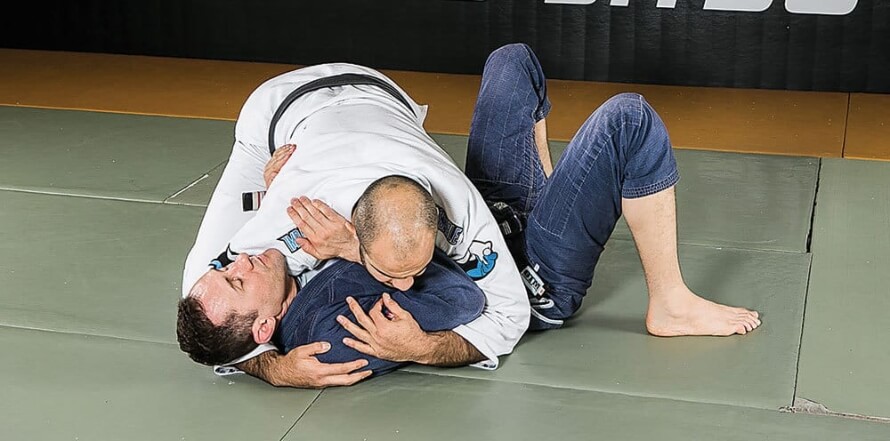
Side control is a position in which your body is on top of your opponent’s and oriented at a 90-degree angle. There are many different side control variations, depending on how you position your body, and all of them have pros and cons. Like the mount, side control creates many ways for you to dominate or submit your opponent while limiting their means of defense.
3. Guard
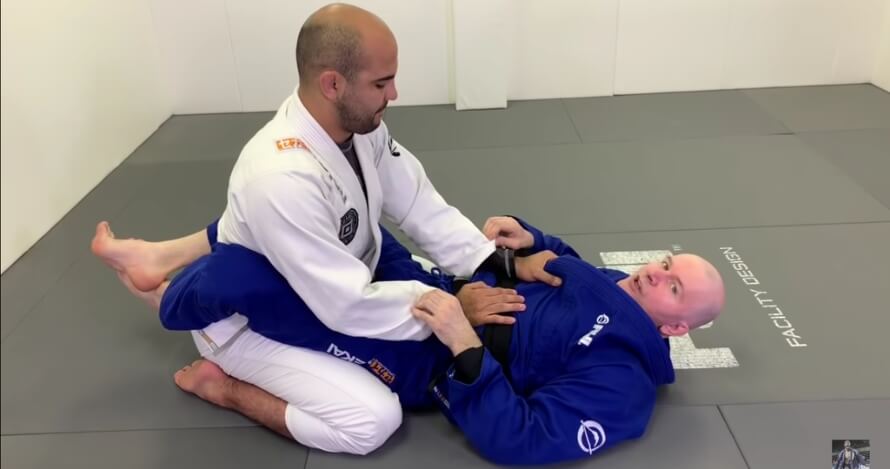
Guard is a position where you’re on your back and attempting to control your opponent with your legs. Most people who are new to BJJ first learn what’s referred to as the closed guard, which means your legs are wrapped around your opponent’s body and overlap behind their back. Guard is primarily a defensive position, but it also serves as the foundation for many sweeps and submissions.
4. Half Guard
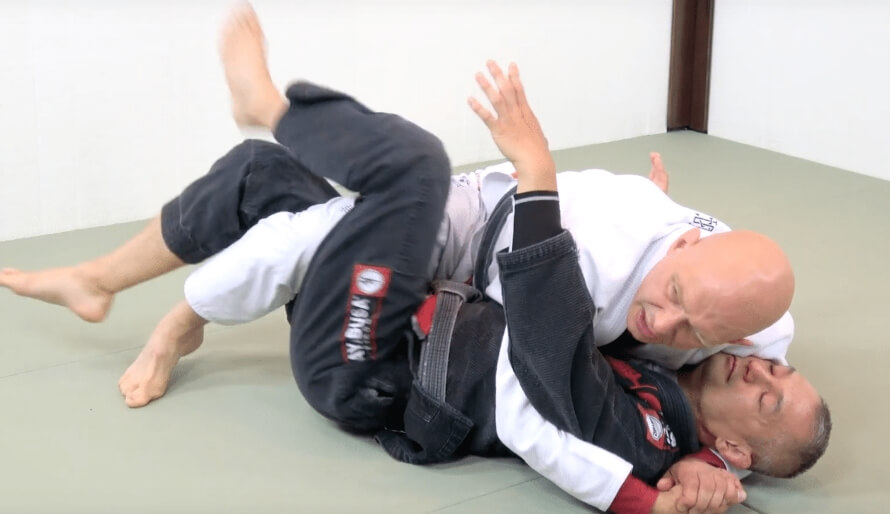
Half guard is the same as guard, except instead of having both of your legs wrapped around your opponent, you have them wrapped around one of their legs.
5. Back Mount
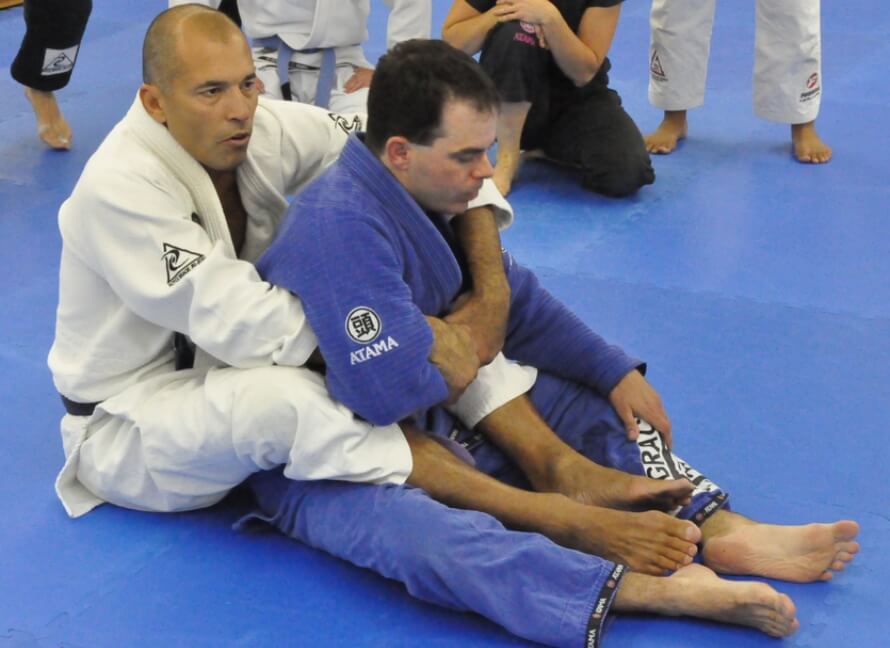
Back mount is a position where you straddle your opponent’s back with your legs wrapped around their torso. This is considered one of the best positions to be in, as it allows you to make many different attacks, especially chokes, it prevents your opponent from attacking you, and it gives you the option to change to a different position at any time you like. Basically, you’re in control of the fight.
6. Turtle
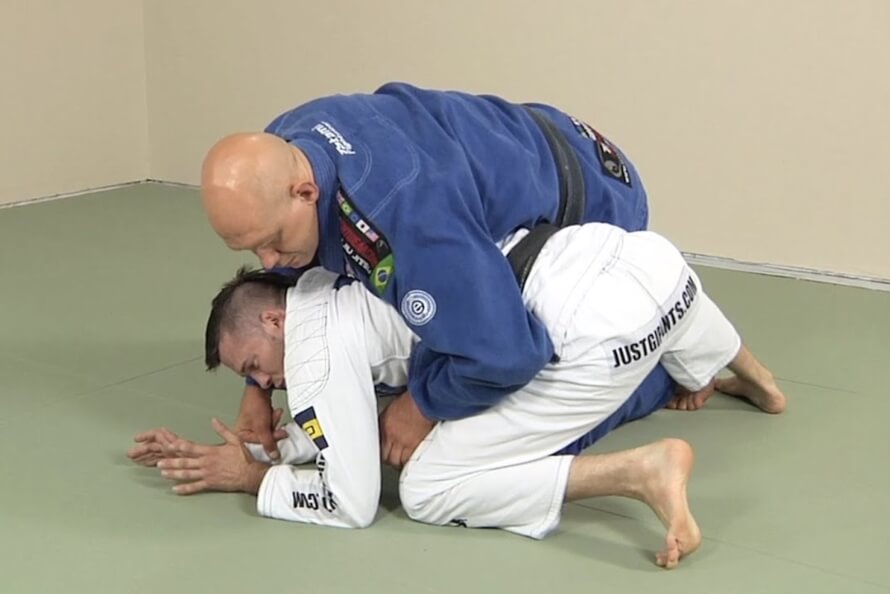
Turtle is a position where you’re on your hands and knees with your head drawn close to your body. Usually, your opponent will be on top of or behind you when you’re in the turtle position. The turtle is a defensive position from which you can foil your opponent’s attacks or make one of your own.
7. Knee on Belly
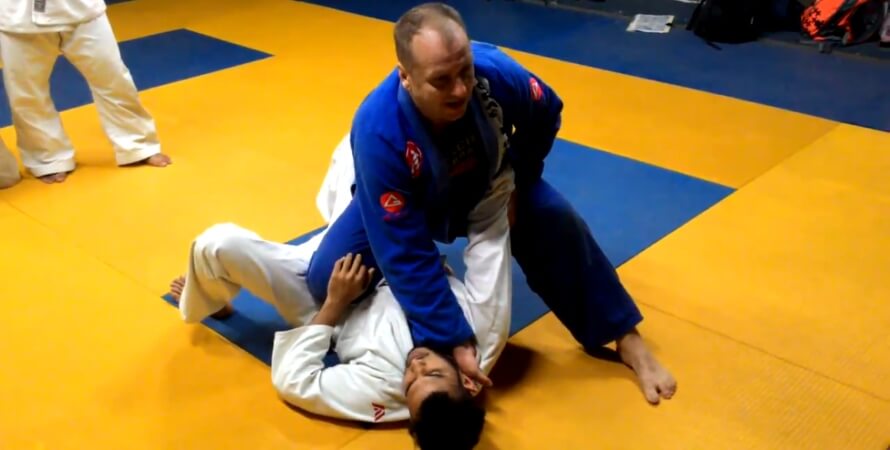
Knee on belly is exactly what it sounds like—you put your knee on your opponent’s belly while facing their torso. While this doesn’t sound so sinister, it’s an effective way to throw your opponent off their stride and open them up for submissions. It’s also very uncomfortable, which forces your opponent to work hard to escape it (which wastes energy and opens them up to attack).
Strength Training for BJJ
Being strong is an advantage in BJJ, but this is mostly true when you’re facing an opponent roughly your skill level or worse. If you’re grappling with someone who’s better at BJJ than you are, they’re probably going to win, even if you’re much bigger and stronger. (See FAQ #5 below).
That is, after all, the spirit of the sport.
That said, there are a few reasons weight training for BJJ may be profitable:
- It improves your body composition, helping you get leaner and fitter, which indirectly improves your BJJ game.
- It strengthens your joints, tendons, and other connective tissues, which may reduce your risk of injury.
- It improves your ability to dominate fighters at the same or a lower skill level (again, though, it won’t save you from someone who’s much more technically proficient).
If you’d like to learn more about how to combine BJJ (or other sports) with strength training, check out my article on concurrent training:
Concurrent Training: The Right Way to Combine Cardio and Strength Training
Nutrition for BJJ
Brazilian Jiu-Jitsu burns a lot of calories, so it’s important to make sure you eat enough to fuel your workouts.
That said, the leaner and lighter you are, the faster and more efficient you’ll be, and you’ll increase your odds of success in sparring and competition. Thus, it pays to thread the needle between eating enough to maintain your performance while getting or staying lean.
In other words, the better your body composition, the more fruitful and enjoyable your training will be.
If you’d like to trim down for BJJ, check out our definitive guide on how to lose fat:
The Complete Guide to Safely and Healthily Losing Weight Fast
FAQ #1: Is BJJ good for beginners?
Yes! One of the reasons BJJ has become so popular is because it’s very beginner friendly.
Virtually all BJJ gyms offer beginner classes, and good instructors work hard to ensure you progress at an appropriate, safe pace.
FAQ #2: What should I expect in my first BJJ class?
Most BJJ classes follow a three-act structure:
- You’ll often start with a warm up, which typically involves shrimping, rolling, bridging, and other fundamental BJJ movements.
- Then, the instructor will generally demonstrate and explain several movements, which could include submissions, guards, mounts, and so on.
- Finally, most classes end with a period of rolling, aka grappling or sparring, where you pair up with another student and practice what you learned in a realistic setting. These “matches” can be as intense or relaxed as you want to make them, and it’s often smart to press pause to go over a particular aspect of your technique rather than going balls to the wall.
FAQ #3: Can you teach yourself BJJ?
You can learn the broad strokes of BJJ by reading books and articles and watching and listening to videos and interviews, but you won’t internalize the movements and develop a keen sense of when to use them unless you take a class. So, no, you can’t really learn BJJ on your own.
FAQ #4: How many times a week should a beginner do BJJ?
Two-to-three times per week tends to work best for most beginners.
If you’re pressed for time, once per week is still better than nothing. You can do more than three classes per week if you want to progress faster, but you may be better off cooling your jets to avoid beating yourself up or getting burned out.
FAQ #5: Does strength training make you better at BJJ?
All else being equal, the stronger and fitter you are, the better you’ll be at BJJ.
Of course, the essence of BJJ is learning to defeat bigger, stronger, more energetic opponents using leverage, skill, and finesse—to ensure everything isn’t equal—so brute force will only carry you so far.
I made this blunder when I first started training in BJJ. I’m fairly strong by most standards (1,065-pound total at 170 pound body weight as I write this) and also have decent cardio (sub-6:00 mile run), so I figured that even though I’d be technically inept, my strength and endurance would occasionally tip the scales in my favor.
And I was sort-of right. When grappling with other white belts who were as green as me or even a little better, I’d often outmuscle or outlast them. Against more seasoned white belts, I’d usually survive the whole round, which I chalked up as a W.
Against blue belts, I was lucky to last 60 seconds, and spent most of that time flailing at my partner while he wiped the mat with my face. This little tragic comedy also played out regardless of whether I sparred with a 120-pound skinny fat kid or a boarlike Russian named Boris.
The lesson?
While being strong and fit will amplify your BJJ skills, it can’t replace them.










